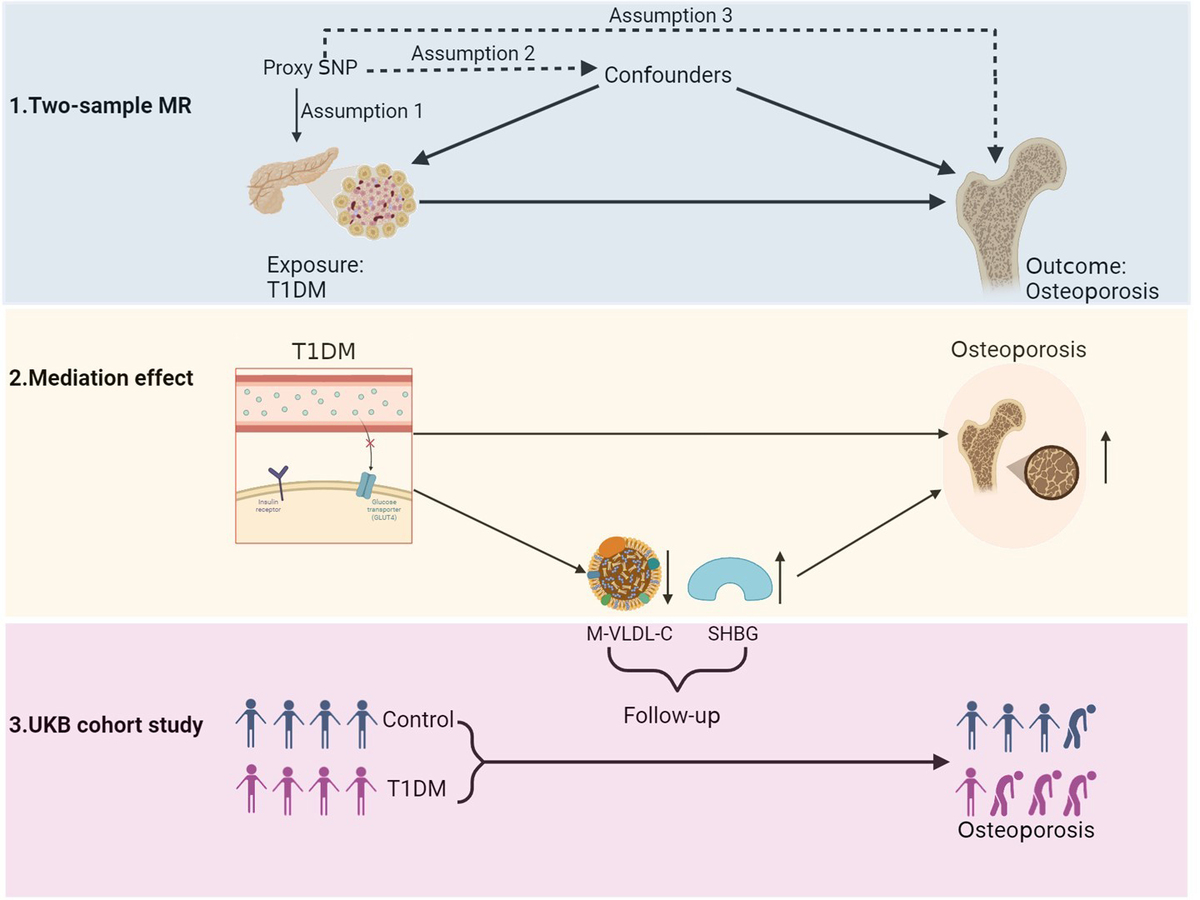Current issue
Archive
Manuscripts accepted
About the Journal
Editorial office
Editorial board
Section Editors
Abstracting and indexing
Subscription
Contact
Ethical standards and procedures
Most read articles
Instructions for authors
Article Processing Charge (APC)
Regulations of paying article processing charge (APC)
OSTEOPOROSIS / RESEARCH PAPER
Metabolic Mediators Linking Type 1 Diabetes Mellitus to Osteoporosis
1
Wuhan Renmin Hospital, China
2
Wuhan Union Hospital, China
3
Tongji Hospital, China
These authors had equal contribution to this work
Submission date: 2024-10-20
Final revision date: 2025-01-23
Acceptance date: 2025-02-23
Online publication date: 2025-04-27
KEYWORDS
TOPICS
ABSTRACT
Introduction:
The causal relationship between type 1 diabetes mellitus (T1DM) and osteoporosis has not been clarified in large prospective cohort studies. This study aims to determine the causal link between T1DM and osteoporosis, and further identify eligible mediators.
Material and methods:
We explored the causal relationship between T1DM and osteoporosis by two-sample Mendelian randomization (MR), a method that uses genetic variants as instrumental variables for causal inference. We selected five candidate mediators based on their relevance to metabolic processes in T1DM and bone health, including body mass index (BMI), glycated hemoglobin (HbA1c), cholesterol in medium very low-density lipoprotein particles (M-VLDL-C), saturated fatty acids (SFA), and sex hormone-binding globulin (SHBG), and identified eligible mediators by two-step MR. We validated the correlation of T1DM and mediators with osteoporosis in a UK Biobank (UKB) prospective cohort study.
Results:
In MR analysis, T1DM was related to a significantly increased risk of osteoporosis (OR=1.046, 95% CI: 1.015 to 1.079, P=0.004). In two-step MR, T1DM was significantly associated with decreased levels of M-VLDL-C and SFA, increased levels of SHBG, but showed no significant effect on BMI or HbA1c. Furthermore, lower levels of M-VLDL-C and higher levels of SHBG, but not SFA, were significantly associated with an elevated risk of osteoporosis. Hence M-VLDL-C and SHBG were identified as eligible mediators. In UKB cohort study, consistent results were found.
Conclusions:
T1DM may cause osteoporosis by decreasing M-VLDL-C and increasing SHBG levels in plasma. The identified mediators may serve as important biomarkers for early detection and treatment of osteoporosis in T1DM patients.
The causal relationship between type 1 diabetes mellitus (T1DM) and osteoporosis has not been clarified in large prospective cohort studies. This study aims to determine the causal link between T1DM and osteoporosis, and further identify eligible mediators.
Material and methods:
We explored the causal relationship between T1DM and osteoporosis by two-sample Mendelian randomization (MR), a method that uses genetic variants as instrumental variables for causal inference. We selected five candidate mediators based on their relevance to metabolic processes in T1DM and bone health, including body mass index (BMI), glycated hemoglobin (HbA1c), cholesterol in medium very low-density lipoprotein particles (M-VLDL-C), saturated fatty acids (SFA), and sex hormone-binding globulin (SHBG), and identified eligible mediators by two-step MR. We validated the correlation of T1DM and mediators with osteoporosis in a UK Biobank (UKB) prospective cohort study.
Results:
In MR analysis, T1DM was related to a significantly increased risk of osteoporosis (OR=1.046, 95% CI: 1.015 to 1.079, P=0.004). In two-step MR, T1DM was significantly associated with decreased levels of M-VLDL-C and SFA, increased levels of SHBG, but showed no significant effect on BMI or HbA1c. Furthermore, lower levels of M-VLDL-C and higher levels of SHBG, but not SFA, were significantly associated with an elevated risk of osteoporosis. Hence M-VLDL-C and SHBG were identified as eligible mediators. In UKB cohort study, consistent results were found.
Conclusions:
T1DM may cause osteoporosis by decreasing M-VLDL-C and increasing SHBG levels in plasma. The identified mediators may serve as important biomarkers for early detection and treatment of osteoporosis in T1DM patients.
Share
RELATED ARTICLE
We process personal data collected when visiting the website. The function of obtaining information about users and their behavior is carried out by voluntarily entered information in forms and saving cookies in end devices. Data, including cookies, are used to provide services, improve the user experience and to analyze the traffic in accordance with the Privacy policy. Data are also collected and processed by Google Analytics tool (more).
You can change cookies settings in your browser. Restricted use of cookies in the browser configuration may affect some functionalities of the website.
You can change cookies settings in your browser. Restricted use of cookies in the browser configuration may affect some functionalities of the website.



